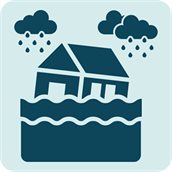Assumptions & limitations for pluvial floods
The dataset provides an initial, national-level indication of the impact of severe precipitation. Several representative areas were verified using local observations and insights, and the outcomes were reasonably consistent. However, more detailed calculations will produce better results. These results can be verified with observations, if available.
Several other assumptions and limitations to consider when using the dataset are:
- As the datasets provides an initial indication of the pluvial flood impact, the information cannot serve as the basis for establishing priorities in measures to be implemented. The modelling focused on local pluvial flooding resulting from short, severe precipitation. Such short downpours often cause the most problems in built-up environments, where water runs off quickly and does not infiltrate much. Non-built-up environments – that respond more slowly and over a larger surface area – pluvial flooding tends to be caused by prolonged, multi-day precipitation. This map does not provide insight into such matters, and without modifications, it cannot be used to model regional waterlogging caused by prolonged precipitation.
- In the development of the water depth maps – which were made using a simplified hydrodynamic model- several general assumptions were made, including those regarding the drainage capacity of the sewer system. On a local scale, details – such as the exact location of basins and pumps – can significantly influence the expected water depth.
- The dataset does not indicate how long water remains after heavy precipitation, even though this duration is an important factor in determining the consequences of pluvial flooding.
- In areas with slopes, water flow velocity on the surface can cause additional impacts. Capturing this information requires tailored information, which is not included in this dataset.
More information about the assumptions and limitations can be found on the Climate Adaptation Knowledge Portal.

